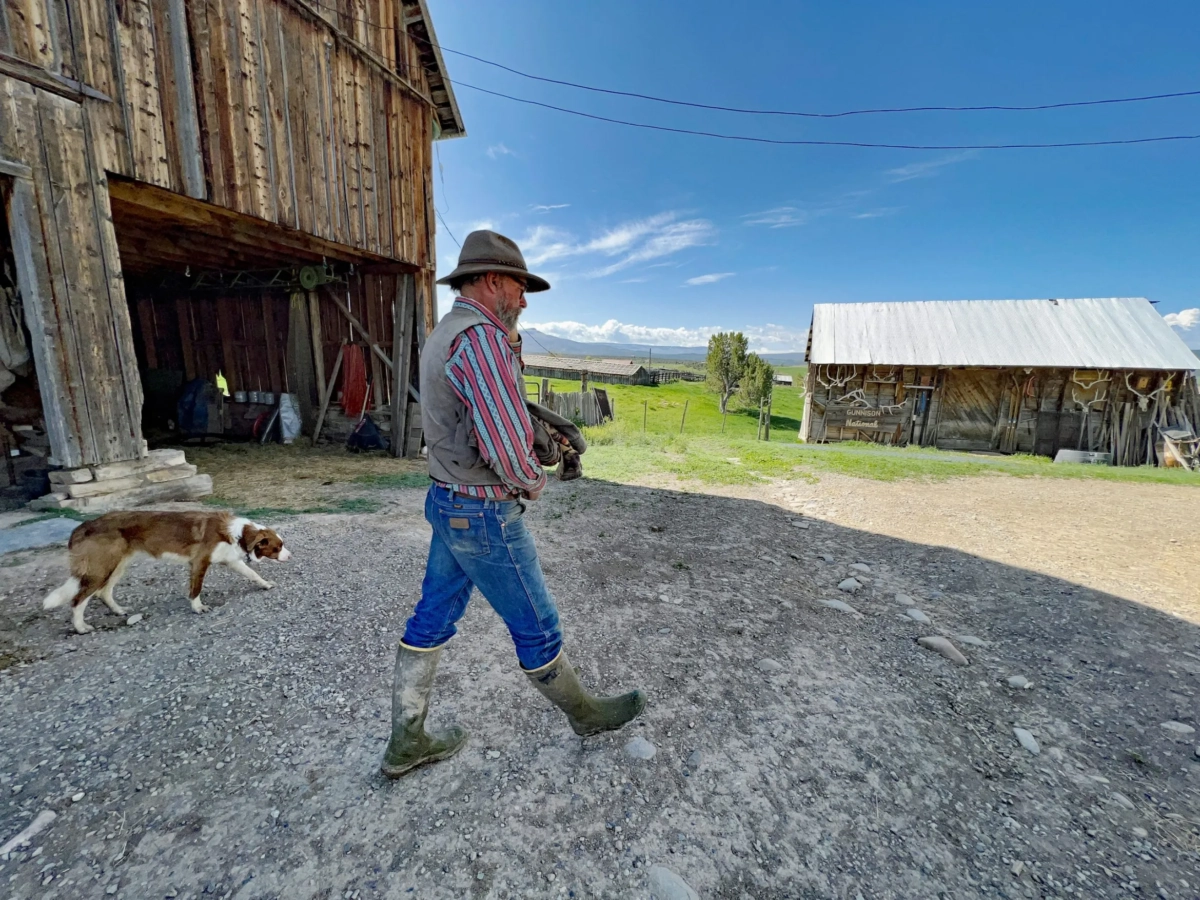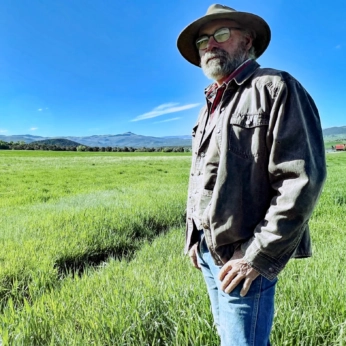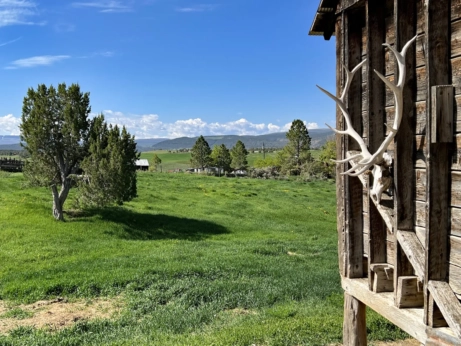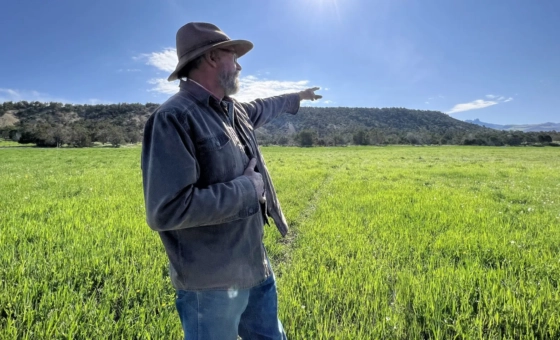Perceptions Vary as Colorado Prepares for Wolf Reintroduction
Where some see mortal threat, others focus on ecosystem benefit.
Perceptions Vary as Colorado Prepares for Wolf Reintroduction
Where some see mortal threat, others focus on ecosystem benefit.

Tony Prendergast and Django head out for a day’s work on the XK Bar ranch in Crawford, Colorado. Prendergast is in favor of wolf reintroduction and fully expects wolves on his ranch within a year after the first are released.by Amy Hadden Marsh/Aspen Journalism
Tony Prendergast’s XK Bar Ranch sits slightly south of Crawford, Colorado, near the Smith Fork of the North Fork of the Gunnison River on the southern edge of the agriculturally rich North Fork Valley. The Black Canyon of the Gunnison lies to the southwest. The 260-acre ranch butts up against the West Elk Mountains, four miles east of the West Elk Wilderness, almost smack-dab in the middle of where gray wolves could be released this winter.
He lives in a small, strawbale house, built in the trees next to the main pasture. His cow dogs, Huckle and Django, follow him everywhere. His son, Darby, is a ranch partner and lives in an airy, 100-year-old house on the property with his girlfriend and two dogs, Pancho and Lefty.
I met Prendergast, the dogs, the son, the girlfriend, a barn cat and a herd of six horses, including two mustangs on a mid-May morning. Meadowlarks were singing forte voce in the fields. I drove 10 hours round-trip for a three-hour conversation because he is a Western Slope cattle rancher who supports wolf reintroduction. “I may eat my words,” he told me. “But I’m willing to accept the challenge.”
Colorado Parks and Wildlife (CPW) approved the Colorado Wolf Restoration and Management Plan (CWRMP) in early May after years of contentious discussion and debate. Prendergast believes that choosing to put wolves on the landscape is a choice for biodiversity. “It’s the key to human survival,” he said. “And it could help drive land and big game conservation.” He admits that wolves will present challenges for livestock producers, but he added, “There may be some interesting new opportunities that come up for ranchers and for all of us here in western Colorado. I’m open-minded about it.”
Prendergast, 58, has been on the XK Bar for 25 years. ”We bought the ranch by forming a land cooperative with three other families and collaborating on different uses of the land,” he said. One partner rejuvenated the old apple orchard, planted another 120 heritage-variety trees and started a cider business. “A couple of the other partners’ interests were land conservation and low impact residential sites integrated into the agricultural and natural ecology of the ranch,” he said.
The XK Bar is not a cow/calf outfit. Although Prendergast still grazes other people’s cattle and sells surplus hay, he started a grass-fed cattle finishing operation in 2011. “I basically do what a feedlot would do, except I’m doing it on grass,” he said. “Then I direct-market and sell the meat.” He purchases weaned calves and finishes most of them on an 80-acre pasture on the ranch. Every few years, he said, all 260 acres will be grazed. “I use the dry rangeland as a drought reserve,” he said. “I’ll let vegetation build up and develop roots in the good years, and then it can provide some additional grazing when forage is short in the drought years.”
He also leases 280 acres nearby in elk winter range right below the West Elk Mountains. For the past few years, he has been taking his herd to a ranch in Delta in midwinter where snow is light and he can hold onto his hay reserves.
Regenerative agriculture is Prendergast’s thing. “It’s what gets me up in the morning,” he said. “It’s what I believe in.” He said the practice enhances ecosystems, adding greater complexity, more biodiversity, more resilience. The XK Bar is in a pastoral ecosystem of big grass and brushlands that support grazing animals. “There’s virtually no farming up here where I’m at,” he said. “But it’s a tremendous grassland.” He added that this is part of what draws people to the area. “There is a lot of hunting, a lot of people coming to this area to enjoy the beauty, the wild mountains, the wilderness areas, and the open landscapes and vistas,” he said. “And if we’re going to tend that toward more complexity and more biodiversity, wolves at some point will have a place in that.”
He added that making space for wolves and incorporating their presence into human activity is the right thing to do. “When there are wolves on the landscape, [humans] are still a dominant force, but there’s something else that gets more of our attention,” he said. “To be able to have a culture that does that, I think would be a finer place to live.”

In 2020, Colorado voters narrowly passed Proposition 114, which set in motion the plan to reintroduce wolves by this Dec. 31. Twelve of the state’s 64 counties voted in favor of bringing wolves to the state. Only five of those are on the Western Slope, home of the proposed wolf-release sites and the lion’s share of ranchers, hunters and outfitters who spoke up at CPW meetings. The other seven counties that supported the measure are on the Front Range and include the large, urban voting blocks of Boulder, Larimer, Jefferson and other Denver-area counties.
Like many livestock growers, Renee Deal, a fourth-generation sheep rancher from Somerset, is chafed by how the statewide vote shook out. Her gripe is that urban residents voted for wolf reintroduction but ranchers on the Western Slope will have to deal with the consequences. “I don’t feel like we should have to sacrifice our animals and our bottom line because some people [on] the Front Range want to see the majestic wolf in the wild,” said Deal, an appointed member of the Stakeholder Advisory Group (SAG), which made recommendations to the CWRMP about conservation objectives and wolf-management strategies.
She told Aspen Journalism that livestock growers came into the discussions of the wolf-reintroduction plan as losers, which is why she got involved with SAG. “The first concession we made is we have to have wolves that we have to accept,” she said. “And we can’t legally control them unless there’s some very specific circumstances.”
By “legally control,” Deal is referring to lethal control, or the ability to kill wolves that kill livestock. The circumstances that would allow for that have remained contentious over the course of reintroduction-management planning. The U.S. Fish and Wildlife Service (FWS) has nearly completed a rulemaking process to put a so-called 10(j) rule in place prior to reintroduction. The rule will grant authorization for ranchers to lethally control wolves that prey on livestock. Ranchers have been fighting for a lethal-control option and reimbursement for livestock lost to wolves.

Wolf habitat models informing the final CWRMP showed adequate habitat within Colorado to support a self-sustaining wolf population. Those same models overlaid areas where landscape ecology benefits wolves upon areas with the potential for wolf-human conflict. Added to this were studies of wolves released in Yellowstone National Park and central Idaho, which found that wolves eventually moved an average of 50 miles from release sites. Colorado Revised Statute 33-2-105.8, which came out of Proposition 114, limits release sites to the Western Slope.
So CPW, knowing that the state can ecologically support wolves, had to determine release sites on state and private land west of the Continental Divide within the parameters of minimal human conflict and low risk of immediate migration to neighboring states. CWRMP settled on sites at least 60 miles from the Wyoming, Utah and New Mexico borders and from Southern Ute tribal lands.
Initial release sites will be within two main areas. The northern area includes the Interstate 70 corridor between Glenwood Springs and Vail and the Roaring Fork Valley. The southern area centers on the Highway 50 corridor between Monarch Pass and Montrose.
Most Western Slope ranchers and outfitters are upset about the prospect of wolves in the wild, as evidenced by comments made at cattlemen’s association and CPW meetings throughout the management planning process. “We’re nervous. We’re scared,” Meeker resident Ann Marie Scritchfield said at a February CPW meeting in Rifle. Scritchfield is the owner/operator of Sable Mountain Outfitters. Her family has operated the business out of Rio Blanco County for close to 25 years. “Everyone’s fearful of losing their livelihoods.”
Brent Cose, an outfitter from western Garfield County, stated that the “devil wolf” was coming for all children. “How many kids are going to be killed by the wolf? How many families are going to be disemboweled by these wolves?” he said. “Why don’t you name the one you collared [in North Park in February] Satan or Lucifer because it is the devil.”
Hyperbole aside, rancher and outfitter concerns are real: They don’t want wolves to kill livestock or big game because that means less money in the bank. Dead cows, dead sheep and dead elk do not a good business make.
Dale Coombs, co-owner of D&G Horses and Outfitting in Rifle and Meredith, said outfitting has been the family business for almost five decades. “It has always been my hope that someday I could pass this business on to my children and grandchildren,” he told the Colorado Parks and Wildlife Commission at the same meeting. “But that dream is fading fast due to the fact that all indications are that the area in which we operate may very well be ground zero for wolf releases.”

Carter Neimeyer is an Idaho-based wolf expert who has written two books on his experiences with Canis lupus. He is a former U.S. Department of Agriculture Wildlife Services wolf-management specialist in Idaho, Montana and Wyoming. He also ran the U.S. Fish and Wildlife Service’s wolf-recovery program in Idaho, starting in 2001. Niemeyer was a member of CPW’s Technical Working Group (TWG). “I haven’t heard of anyone going out of business,” he told Aspen Journalism. “I would say that the only effect on outfitters that I am aware of is that it gives them one more animal to provide hunting opportunities for.”
Hunting wolves is legal in Idaho, Montana and Wyoming. Hunting wolves for sport will not be allowed at least at the outset of reintroduction in Colorado. But Neimeyer said outfitters here could offer a kind of non-lethal hunting trip. “Let us take you on a horseback ride, a campout. Let us take you out and show you wolves. Let us provide the opportunity for you to hear them,” he said. “It offers them another positive aspect in their business.”
As for wolves decimating elk herds, Neimeyer doesn’t buy it. “I’m aware of the constant rhetoric, the anti-wolf sentiment of hunters and outfitters and politicians who blatantly misrepresent the science talking about the detrimental effects of wolves on elk,” he said. “It’s common knowledge and you can find it throughout the media that elk herds in Idaho, Montana, Wyoming have increased over the 27 years since wolf reintroduction.”
Idaho Fish and Game, the state wildlife management agency, in 2020 reported herd sizes above or consistent with state management objectives in more than 70% of the state’s hunting zones.
Neimeyer pointed to hunting units 10 and 12, in Idaho’s Lolo region, that he believes are used as examples of how wolves are hurting elk herds. “But that is a fire-suppression issue, a habitat issue, that’s been going on for just about as long as the wolf reintroduction,” he said, adding that until the Great Fire of 1910, which burned more than 3 million acres of forest across northern Idaho and western Montana, elk hunting was good in those areas. “What’s happened is that the forest has grown back,” he said, adding that fire-suppression efforts have changed the landscape. “If you want good elk habitat, you need fires,” he said. “You need that heavy forest canopy removed so that elk and other critters can browse on the understory.”
Regarding Colorado’s Western Slope, a 2019 study by Paul Millhouser for Rocky Mountain Wild that focused on herds in the Roaring Fork and Eagle valleys — where wolves could be released in December — found that elk numbers peaked in the mid-1990s. They declined by more than half from 1999 to 2015 and have yet to recover.
Around the time of the population peak, CPW issued more cow elk licenses. But population declines began to exceed expectations, and subsequently, fewer licenses have been issued. Other factors contributing to elk decline include climate and weather, habitat use and other predators. But, said Millhouser, human presence, such as hunting, development and recreation, was a major influence on elk decline between 1981 and 2017. A 2022 CPW study of elk in the Craig/Steamboat Springs area and the Avalanche Creek herd between Glenwood Springs and Aspen acknowledges that human encroachment has affected herd size.

If enough wolves inhabit Colorado over time, perhaps the size of some big-game herds will decrease. Yellowstone’s Northern Range elk herd decreased after the reintroduction of wolves, but the direct connection between wolf predation and elk decline is difficult to nail down.
Prendergast has a lifetime of ranch work, outfitting and wilderness rangering behind him. He understands how outfitters might be discouraged. “Hunters and a lot of outfitters are terrified about the elk herds being decimated by wolves,” he said. “But what’s decimating the elk herds is cars and people and homes being built, and all the human recreational activities in elk calving grounds that are just ramping up and up.”
He fully expects to see wolves on the XK Bar in 2024. “Come next November, if wolves show up, it will almost certainly be me who will go camp near my herd,” he said. “At least, for starters, until we start figuring out and getting comfortable with other strategies.”
He might graze his herds closer to main roads or houses, and consider putting up fladry — fabric strips along a fenceline that flap in the breeze — to scare off predators. “I think one of the biggest things is to try to have close communication with CPW and really know when wolves are in the immediate vicinity or heading towards our valley,” he said. “I assume the first bunch of wolves will all be collared and closely monitored.”
Another strategy is lethal control or actually killing wolves that kill livestock, which Prendergast supports. The U.S. Fish and Wildlife Service in September released a draft record of decision on an environmental impact statement for Colorado wolf reintroduction that endorses the 10(j) rule. Barring any last-minute reversal, the rule will go into effect before the first wolves are released. The rule designates reintroduced wolves as an “experimental, non-essential” population, thereby federally downlisting them in Colorado and giving livestock growers broad authority to kill any wolf when there is evidence of livestock depredation. Without the 10(j) rule, wolves remain federally endangered in Colorado. Killing one is illegal in all cases except self-defense.
Part 2 of Aspen Journalism’s wolf-reintroduction coverage takes a look at the 10(j) rule and the politics involved in getting paws on the ground. Aspen Journalism is an independent nonprofit news organization. See www.aspenjournalism.org for more.
Follow us
This work is licensed under a Creative Commons Attribution-NoDerivatives 4.0 International License.
Want to republish a Modern Farmer story?
We are happy for Modern Farmer stories to be shared, and encourage you to republish our articles for your audience. When doing so, we ask that you follow these guidelines:
Please credit us and our writers
For the author byline, please use “Author Name, Modern Farmer.” At the top of our stories, if on the web, please include this text and link: “This story was originally published by Modern Farmer.”
Please make sure to include a link back to either our home page or the article URL.
At the bottom of the story, please include the following text:
“Modern Farmer is a nonprofit initiative dedicated to raising awareness and catalyzing action at the intersection of food, agriculture, and society. Read more at <link>Modern Farmer</link>.”
Use our widget
We’d like to be able to track our stories, so we ask that if you republish our content, you do so using our widget (located on the left hand side of the article). The HTML code has a built-in tracker that tells us the data and domain where the story was published, as well as view counts.
Check the image requirements
It’s your responsibility to confirm you're licensed to republish images in our articles. Some images, such as those from commercial providers, don't allow their images to be republished without permission or payment. Copyright terms are generally listed in the image caption and attribution. You are welcome to omit our images or substitute with your own. Charts and interactive graphics follow the same rules.
Don’t change too much. Or, ask us first.
Articles must be republished in their entirety. It’s okay to change references to time (“today” to “yesterday”) or location (“Iowa City, IA” to “here”). But please keep everything else the same.
If you feel strongly that a more material edit needs to be made, get in touch with us at [email protected]. We’re happy to discuss it with the original author, but we must have prior approval for changes before publication.
Special cases
Extracts. You may run the first few lines or paragraphs of the article and then say: “Read the full article at Modern Farmer” with a link back to the original article.
Quotes. You may quote authors provided you include a link back to the article URL.
Translations. These require writer approval. To inquire about translation of a Modern Farmer article, contact us at [email protected]
Signed consent / copyright release forms. These are not required, provided you are following these guidelines.
Print. Articles can be republished in print under these same rules, with the exception that you do not need to include the links.
Tag us
When sharing the story on social media, please tag us using the following: - Twitter (@ModFarm) - Facebook (@ModernFarmerMedia) - Instagram (@modfarm)
Use our content respectfully
Modern Farmer is a nonprofit and as such we share our content for free and in good faith in order to reach new audiences. Respectfully,
No selling ads against our stories. It’s okay to put our stories on pages with ads.
Don’t republish our material wholesale, or automatically; you need to select stories to be republished individually.
You have no rights to sell, license, syndicate, or otherwise represent yourself as the authorized owner of our material to any third parties. This means that you cannot actively publish or submit our work for syndication to third party platforms or apps like Apple News or Google News. We understand that publishers cannot fully control when certain third parties automatically summarize or crawl content from publishers’ own sites.
Keep in touch
We want to hear from you if you love Modern Farmer content, have a collaboration idea, or anything else to share. As a nonprofit outlet, we work in service of our community and are always open to comments, feedback, and ideas. Contact us at [email protected].by Amy Hadden Marsh, Aspen Journalism, Modern Farmer
November 15, 2023
Modern Farmer Weekly
Solutions Hub
Innovations, ideas and inspiration. Actionable solutions for a resilient food system.
ExploreExplore other topics
Share With Us
We want to hear from Modern Farmer readers who have thoughtful commentary, actionable solutions, or helpful ideas to share.
SubmitNecessary cookies are absolutely essential for the website to function properly. This category only includes cookies that ensures basic functionalities and security features of the website. These cookies do not store any personal information.
Any cookies that may not be particularly necessary for the website to function and are used specifically to collect user personal data via analytics, ads, other embedded contents are termed as non-necessary cookies.
If you people think wolves are so great, I’ll tell you what they do to the elk herds. 2 years ago, I could drive 20 miles and hunt an abundance of elk, now that wolves have been introduced there are no elk to find anywhere. So in 2 years the wolves have decimated the entire herd. And when they have no deer and elk to eat, well guess what, they come down to lower lands and go for domestic animals. Last year we had a wolf chasing our horse, and legally, there’s nothing we could do except shoot in the… Read more »